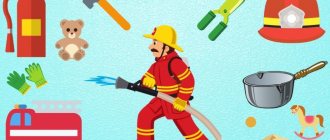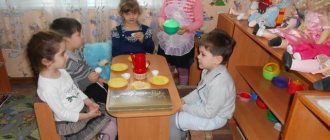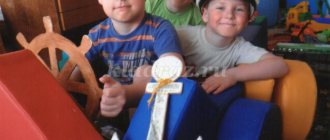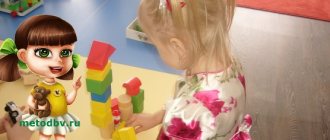Card index of role-playing games for middle-aged children
“Card index of plot-role-playing games in the middle group”
"Family"
Program content:
Strengthen children’s ideas about the family and the responsibilities of family members.
Develop interest in the game. Teach children to assign roles and act according to the role they assume, to develop the plot. Encourage children to creatively reproduce family life through play. Learn to act in imaginary situations, use various objects - substitutes. Foster love and respect for family members and their work. Playing material:
Furniture, dishes, attributes for equipping a house, “kindergarten”, large construction set, toy car, baby doll, toy stroller, bags, various substitute items.
Preliminary work:
Conversations: “My family”, “How do I help my mother”, “Who works for whom?”
“What do we do at home?” Examination of plot pictures, photographs on the topic. Reading fiction: N. Zabila “Yasochka’s kindergarten”, A. Barto “Mashenka”, B. Zakhoder “Builders”, “Driver”, D. Gabe from the series “My Family”: “Mom”, “Brother”, “Work” ", E. Yanikovskaya "I go to kindergarten", A. Kardashova "Big wash". Playing roles:
mother, father, grandmother, grandfather, eldest daughter, preschool children, baby doll.
The following scenes are played out:
“Morning in the family” “Lunch in the family” “Construction site” “Dad is a good owner” “We have a baby in our family” “Evening in the family” “Mom puts the children to bed” “Day off in the family” “In the family” a child is sick" "We help mom wash clothes" "Big cleaning of the house" "We have guests" "Moving to a new apartment" "Family holiday: mother's day, New Year, birthday" Game
actions: Mom-teacher
gets ready and goes to work;
prepares everything necessary for activities with children; accepts children and works with them; plays, walks, draws, teaches, etc.; gives children to parents, cleans the workplace; returns home from work; relaxes, communicates with her children and husband; helps grandma, puts the children to bed. A housewife mother
gathers and escorts her daughter to kindergarten and her husband to work;
takes care of the youngest child (doll), walks with him, cleans the house, prepares food; meets a child from kindergarten, a husband from work; feeds them, communicates, puts the children to bed. A construction worker dad
gets ready for work, takes his child to kindergarten, goes to work;
builds houses, bridges; returns from work, picks up the child from kindergarten, returns home; helps his wife around the house, plays with the children, communicates. The father-driver
gets ready for work, takes the child to kindergarten, goes to work;
delivers loads (bricks) to the construction site, unloads them, goes for new ones; picks up the child from kindergarten and returns home; helps his wife around the house; invites neighbors over for tea; sees off neighbors; communicates with children, plays with them, puts them to bed. Grandmother
gathers and escorts her grandchildren to kindergarten and school;
cleans the house; turns to her eldest granddaughter for help; picks up her granddaughter from kindergarten and asks the teacher about her behavior; cooks dinner, bakes a pie; asks family members how the work day was; offers to invite neighbors to tea (dinner), treats everyone to a pie; plays with grandchildren; gives advices. Grandfather
helps grandma, dad, reads newspapers, magazines;
plays with grandchildren, communicates with neighbors. The eldest daughter
helps her grandmother prepare food, wash dishes, clean the house, iron clothes;
plays and walks with his younger sister, communicates. Preschool children
get up, get ready and go to kindergarten; in kindergarten they do: play, draw, walk; return from kindergarten, play, help parents, go to bed.
"Kindergarten"
Program content:
Expand children's understanding of the content of labor actions of kindergarten employees.
Induce in children a desire to imitate the actions of adults. Cultivate friendly relationships in games between children. Game material:
Dolls with a set of clothes, furniture, dishes, small toys, mops, buckets, rags, aprons, bathrobes, washing machine, basin, drying rack, ironing board, irons, stove, cookware set, food, vacuum cleaner, musical instruments.
Preliminary work:
Observation of the work of the teacher, assistant teacher.
Conversation with children about the work of a teacher, assistant teacher, cook, nurse and other kindergarten workers. Excursion-inspection of the music (physical education) hall, followed by a conversation about the work of muses. manager (physical supervisor). Excursion-inspection of medical. office, observation of the doctor’s work, conversations from the personal experiences of children. Inspection of the kitchen, conversation about technical equipment that makes the work of kitchen workers easier. Game-dramatization based on N. Zabila’s poem “Yasochkin’s kindergarten” using toys. Excursion to the laundry. Organization of children's work - washing doll clothes, handkerchiefs. Playing roles:
Doctor, nurse, teacher, music worker, physical education director, nanny, cook, laundress.
The scenes are played out:
“Morning reception” “Our classes” “Exercise in kindergarten” “Nanny’s work - breakfast” “Nanny’s work - cleaning the group” “On a walk” “At a music lesson” “At a physical education lesson” “Doctor’s examination” “Lunch” in a kindergarten" "The work of a cook in a kindergarten" "Work in the laundry of a kindergarten"
Play activities: The teacher
receives children, talks with parents, plays with children, conducts classes.
Physical instructor
conducts morning exercises and physical education.
The junior teacher
keeps order in the group, assists the teacher in preparing for classes, receives food...
Music.
the leader conducts music.
class. The doctor
examines the children, listens, and makes prescriptions.
The nurse
measures temperature, height, weighs, gives vaccinations, checks the cleanliness of groups and kitchens.
The cook
prepares food and gives it to the teacher's assistants.
The laundress
washes the clothes, dries them, irons them, folds them neatly, and gives them clean clothes to the nanny.
"Polyclinic"
Program content:
To arouse children's interest in the medical profession.
Develop the ability to creatively develop the plot of the game. Fix the names of medical instruments: phonendoscope, syringe, spatula. To cultivate a sensitive, attentive attitude towards the patient, kindness, responsiveness, and a culture of communication. Vocabulary work:
phonendoscope, spatula, grafting, vitamins.
Game material:
doctor’s coat and cap, nurses’ coats and caps, medical instruments (thermometer, syringe, spatula), bandage, brilliant green, cotton wool, mustard plasters, patient cards, vitamins.
Preliminary work:
Excursion to the medical office.
Observing the work of a doctor. Reading fiction: J. Rainis “The Doll Got Sick”, V. Berestov “The Sick Doll”. A. Barto “Tamara and I”, P. Obraztsov “Treating a Doll”, A. Kardashova “Our Doctor”. Dramatization “The Animals Are Sick.” Review of the album “We are playing “doctor”. Making attributes for the game. Conversations with children “We are being treated by a doctor and a nurse”, “How should we behave in a doctor’s office?” Playing roles:
Doctor, nurse, patient.
They act out the following stories:
“At the doctor’s appointment”, “The doctor called home” “I hurt my finger” “I have a sore throat” “Giving an injection” “Getting a vaccination”
Game actions: The doctor
receives patients, listens carefully to their complaints, asks questions, listens, looks at the throat , makes an appointment.
The nurse
gives injections, gives medicine, vitamins, puts mustard plasters, lubricates wounds, bandages.
The patient
comes to see the doctor, tells what worries him, and follows the doctor’s recommendations.
"I am a driver"
Program content:
Expand children's understanding of the profession of a driver or auto mechanic.
Develop the ability to build role-playing dialogue, use role-playing speech, creativity in the game, using real objects to create a game environment. Cultivate goodwill and willingness to help. Foster a culture of behavior in transport. Vocabulary words:
gas station, gasoline, canister, tanker, conductor, mechanic, baton, inspector, license.
Game material:
tools for repairing cars, a gas pump, building material, a steering wheel, a canister, a hose for simulating filling a car with gasoline, a bucket with a rag, tickets, money, a bag for the conductor, a traffic light, a baton, a traffic police inspector’s cap, driver’s documents (licenses) .
Preliminary work:
Excursion to the bus stop, observation of the bus, taxi and driver’s work.
Introduce simple regulatory gestures: “stop”, “get ready”, “passage is allowed”. Outdoor games: “Pedestrians and Taxi”, “Traffic Light”. Reading and looking at illustrations on the topic “Chauffeurs”. D/i “Attentive driver”, “Recognize the car”, “Repair the car”. Reading: V. Suteev “Different Wheels”, 3. Alexandrova “Truck”, A. Kardashov “Rain Car” E. Motkovskaya “I am a Car” B. Stepanov “Chauffeur”, “Bus Driver”, B. Zhitkov “Traffic Light” N. Kalinina “How the guys crossed the street”, N. Pavlova “By car”. Game roles:
Taxi driver, bus driver, conductor, passengers, truck driver, mechanic, gas station attendant, policeman (traffic police inspector).
The following plots are played out:
“Building a bus” “Learning to drive a bus” “The bus carries passengers” “Car repair” “Fueling the car” “Car washing” “A truck is carrying furniture to a new house” “A truck is carrying cargo (bricks, sand, snow)” “A grocery car carries food (to a store, to a kindergarten, to a hospital)” “I’m taking passengers to the station” “I’ll go to the garage” “We’re going to kindergarten” “We’re driving around the city” “We’re going to visit” “A trip to the country”
Game actions: The taxi driver
delivers passengers to their destination, takes money for travel, takes care of passengers, helps with luggage.
A truck driver
loads and unloads cargo.
The bus driver
drives the bus, turns the steering wheel, gives a signal, troubleshoots problems, makes stops, and announces them.
The conductor
sells tickets, checks travel tickets, keeps order inside the bus, and answers passengers' questions about where it is most convenient for them to get off.
Passengers
get on the bus, buy tickets, get off at stops, give up their seats to older people, passengers with children, help them get off the bus, follow the rules of conduct on public transport, communicate;
preparing for a long trip - packing things, water, food for the trip; they dress up and comb their hair if they go on a visit or to the theater. The mechanic
carries out repair work, checks the condition of the car before the trip, washes the car with a hose - wipes it.
The gas station attendant
inserts the hose, pours in gasoline, and takes the money.
Policeman (traffic police inspector)
- regulates traffic, checks documents, monitors compliance with traffic rules.
"Salon"
Program content:
Introduce the specifics of the work of male and female hairdressers.
To form children’s understanding of how women care for their nails. To teach them to perform several sequential actions aimed at fulfilling their duties. Develop the ability to engage in role interaction and build role dialogue. Foster a culture of communication with “clients” Vocabulary words:
master, hair dryer, apron, cape, razor, manicure.
Game material:
Mirror, bedside table for storing attributes, various combs, bottles, curlers, hairspray, scissors, hair dryer, cape, apron for hairdresser, manicurists, cleaners, hairpins, elastic bands, bows, towel, magazines with hairstyle samples, razor, hair clipper, towels, money, mop, buckets, dust cloths, for the floor, nail polish, nail file, cream jars.
Preliminary work:
Conversation “Why do we need hairdressers.”
Ethical conversation about the culture of behavior in public places. Reading stories by B. Zhitkov “What I saw”, S. Mikhalkov “In the hairdresser”. Excursion to the hairdresser. Consideration of items necessary for the work of a hairdresser. Didactic games “Beautiful hairstyles for dolls”, “Let’s learn how to tie bows”, “Pick a bow for a doll”, “Miracle hairdryer”. Consider shaving items. Making game attributes with children (aprons, capes, towels, nail files, checks, money, etc.). Making the album “Hairstyle Models”. Game roles:
Hairdressers - ladies' master and men's hairdresser, manicurist, cleaning lady, clients (visitors): mothers, fathers, their children.
The following plots are played out:
“Mom takes her daughter to the hairdresser” “Dad takes his son to the hairdresser” “Let’s give the dolls beautiful hairstyles” “We’re going by bus to the hairdresser” “Getting our hair done for the holiday” “Let’s get ourselves in order” “In the men’s room” “Shopping for goods” for a hairdressing salon" "We invite a hairdresser to a kindergarten"
Game activities: The hairdresser in the women's room
puts a cape on the client, dyes hair, washes his hair, towels off, cuts, shakes off the cut strands from the cape, wraps it in curlers, blow-dries the hair, varnishes it, braids braids, pins hairpins, gives recommendations on hair care.
The barber of the men's salon
shaves, washes the hair, blow-dries hair, makes haircuts, combs the clients' hair, shapes the beard and mustache, offers to look in the mirror, refreshes with cologne.
The manicurist
files the nails, paints them with varnish, and applies cream to the hands.
Clients
greet politely while waiting in line - look at albums with illustrations of different hairstyles, read magazines, can drink coffee in a cafe;
asking for a haircut or manicure; they consult, pay money, thank you for your services. The cleaning lady
sweeps, dusts, washes the floor, and changes used towels.
"Shop - Supermarket"
Program content:
To form children’s ideas about the work of people in a store, the variety of stores and their purpose.
Learn to perform different roles in accordance with the plot of the game. Develop visual and effective thinking and communication skills. Cultivate goodwill, the ability to take into account the interests and opinions of playing partners. Vocabulary words:
showcase, cashier, confectionery.
Game material:
display case, scales, cash register, handbags and baskets for customers, seller’s uniform, money, wallets, goods by department, vehicle for transporting goods, cleaning equipment.
“Grocery store”: dummies of vegetables and fruits, various pastries made from salt dough, dummies of chocolates, candies, cookies, cakes, pastries, boxes of tea, juice, drinks, sausages, fish, milk cartons, cups for sour cream, jars from yoghurts, etc. Preliminary work:
Conversations with children “What stores are there and what can you buy in them?”
“Who works in the store?”, “Rules for working with the cash register.” D/i “Shop”, “Vegetables”, “Who needs what?”. Reading the poem “Toy Store” by O. Emelyanova. B. Voronko “A Tale of Unusual Shopping” Making bagels, buns, cookies from salt dough, making candy. Game roles:
Seller, buyer, cashier, store director, driver.
The plots are played out:
“Bakery-confectionery (bread department, store)” “Vegetable store (department)” “Meat and sausage store (department)” “Fish store (department)” “Dairy store (department)” “Grocery store” “Store musical instruments" "Bookstore"
Game actions: The seller
puts on a uniform, offers goods, weighs, packs, lays out the goods on the shelves (designs a display window).
The store director
organizes the work of store employees, makes requests for goods, pays attention to the correct work of the seller and cashier, and monitors order in the store.
Buyers
come shopping, choose a product, find out the price, consult with sellers, follow the rules of behavior in a public place, form a line at the checkout, pay for the purchase at the checkout, and receive a check.
The cashier
receives the money, punches the check, issues the check, and gives the customer change.
The driver
delivers a certain amount of various goods, receives requests for goods from the store director, and unloads the delivered goods.
"Zoo"
Program content:
Enrich children's knowledge about wild animals, their appearance, habits, and nutrition.
Expand children's understanding of the responsibilities of zoo employees. To develop in children the ability to creatively develop the plot of a game using building floor material and to act with it in a variety of ways. Develop speech, enrich vocabulary. Foster a kind, caring attitude towards animals. Vocabulary words:
veterinarian, guide, aviary (cage).
Game material:
“Zoo” sign, building material (large, small), truck with cage, animal toys, food plates, food models, brooms, scoops, buckets, rags, apron with sleeves for workers, tickets, money , cash register, white coat for the veterinarian, thermometer, phonendoscope, first aid kit.
Preliminary work:
A story about a visit to the zoo.
Talk about animals using pictures about the zoo. Conversation “Rules of behavior in the zoo.” Guessing riddles about animals, Reading poems by S.Ya. Marshak “Children in a cage, “Where did the sparrow have dinner?”, V. Mayakovsky “Every page, then an elephant, then a lioness.” Making the album “Zoo”. Drawing and sculpting animals. Didactic games: “Animals and their babies”, “Riddles about animals”, “Who lives where? ", "Animals of hot countries", "Animals of the North". Playing roles:
Zoo director, tour guide, zoo workers (servants), doctor (veterinarian), cashier, builder, visitors.
The following stories are played out:
“We are building cages for animals” “The zoo is coming to us” “Tour of the zoo” “We are going to the zoo” “Purchasing food for animals” “Feeding animals” “Cleaning enclosures (cages)” “Treating animals”
Game activities: The zoo director
manages the operations of the zoo.
The guide
conducts excursions, talks about animals, what they eat, where they live, their appearance, how to treat animals, talks about safety measures and how to care for them.
Zoo workers (servants
) receive food for animals, prepare special food for animals, feed them, clean cages and enclosures, wash their pets, and take care of them.
A doctor (veterinarian)
examines the animal, measures the temperature, gives vaccinations, treats zoo inhabitants, gives injections, and gives vitamins.
The cashier
sells tickets to visit the zoo and excursions.
A builder
is building an enclosure for an animal.
Visitors
buy tickets at the box office and go to the zoo and look at the animals.
"Sailor Fishermen"
Program content:
Teach children to take on and play out the roles of captain, helmsman, sailors, cook, and sailor fishermen.
Continue to teach how to use substitute items and clearly carry out the chain of game actions. Activate children's speech. Foster friendly relationships and a sense of teamwork. Vocabulary work:
Cook, anchor, helm.
Game material:
large building material, captain's cap, caps, guy collars, lifebuoy, medical gown, medical instruments, anchor, steering wheel, binoculars, bucket, mop, cook suit, tableware, toy fish, nets, fish box, money.
Preliminary work:
Reading fiction about fishing, ships, sailors.
View photographs, paintings about the sea, sailors, ships. Conversation "Who works on the ship." Drawing and sculpting fish. Playing roles:
Captain, fishermen, doctor, cook (cook), driver.
The plots are played out:
“We are building a ship” “Sailors are sailing on a ship on the sea” “Sailors are fishing, working as fishermen” “Sailors are checking their health with the ship’s doctor” “Sailors are sailing on the sea, fishing, having lunch” “Sailors go ashore and go to hairdresser" "Sailors bring their catch ashore, hand over the fish to the store" "Sailors sail to a big city and go to the "Zoo" "Sailors returned from a voyage and went to the store" Game
actions: The captain
steers the ship, turns the wheel, looks through binoculars, gives the command to cast off, drop anchor, fish, controls the work of the fishermen, gives the command to moor to the shore.
Sailor fishermen
follow orders, wash the deck, unwind the net, throw it into the sea, catch fish, and put it in boxes.
The doctor
examines sailors before sailing, allows them to go to sea, and treats those who are sick on the ship.
The cook (cook)
prepares food and feeds the sailors.
The driver
drives up to the ship, checks the quality of the fish, buys the fish from the fishermen, loads it into the car and takes it to the store.
"Mail"
Program content:
To form children's ideas about the work of postal workers.
Expand children's understanding of ways to send and receive correspondence. Develop imagination, thinking, speech. Foster independence, responsibility, and the desire to benefit others. Vocabulary work:
seal, parcel, postman, sorter, receiver.
Game materials:
a table for sending and receiving parcels, a mailbox, a postman's bag, envelopes with paper, stamps, postcards, parcel boxes, children's magazines and newspapers, attributes for the character "pigeon", money, wallets, stamps, a car.
Preliminary work:
Excursion to the post office, monitoring the reception of correspondence and mail dispatch.
Conversations about different types of communication: mail, telegraph, telephone, Internet, radio. Watching the films “Holidays in Prostokvashino”, “Winter in Prostokvashino”, “Snowman-Postman”. Reading S. Ya. Marshak “Mail”, Y. Kushan “Postal History”. Making stamp seals, envelopes, postcards, stamps, mailboxes for letters, bags, money, wallets, etc. Collecting postcards, magazines, calendars. Didactic games “Send a letter”, “Journey of a letter”, “What you need to work as a postman”, “How to send a parcel”. Listening to “The Postman's Song” by B. Savelyev. Playing roles:
Postman, sorter, receiver, driver, visitors.
The plots are played out:
“A letter has arrived, a postcard”
“
A carrier pigeon has brought a letter” “Send a greeting card” “Buying a magazine at the post office” “Send a parcel to your grandmother” “A parcel from a fairy-tale hero” “The driver is carrying the mail”
Game actions: The postman
takes it at the post office letters, newspapers, magazines, postcards;
distributes them to addresses; sends correspondence to the mailbox. The visitor
sends letters, postcards, parcels, packs them;
buys envelopes, newspapers, magazines, postcards; complies with the rules of behavior in a public place; takes a turn; receives letters, newspapers, magazines, postcards, parcels. The receptionist
serves visitors;
accepts parcels; sells newspapers, magazines. The sorter
sorts letters, newspapers, magazines, parcels, and puts a stamp on them;
explains to the driver where to go (to the railway, to the airport...). The driver
takes letters and postcards from the mailbox; delivers new newspapers, magazines, postcards, letters to the post office; delivers parcels; delivers letters and parcels by postal machines to trains, planes, and ships.
Attention! Promotion until December 25!
Author: Kulbikova Olga Aleksandrovna
Normal 0
false false false
RU X-NONE X-NONE
/* Style Definitions */ table.MsoNormalTable {mso-style-name:”Normal table”; mso-tstyle-rowband-size:0; mso-tstyle-colband-size:0; mso-style-noshow:yes; mso-style-priority:99; mso-style-parent:””; mso-padding-alt:0cm 5.4pt 0cm 5.4pt; mso-para-margin-top:0cm; mso-para-margin-right:0cm; mso-para-margin-bottom:10.0pt; mso-para-margin-left:0cm; line-height:115%; mso-pagination:widow-orphan; font-size:11.0pt; font-family:”Calibri”,”sans-serif”; mso-ascii-font-family:Calibri; mso-ascii-theme-font:minor-latin; mso-hansi-font-family:Calibri; mso-hansi-theme-font:minor-latin; mso-fareast-language:EN-US;}
Plot-role-playing game in the middle group “Veterinary hospital”.
Target:
enriching social play experiences between children; development of gaming skills based on the plot of “Veterinary Hospital”.
Tasks:
1) Continue to develop the ability to establish multiple role connections in the game “Veterinary Hospital”: veterinarian - patients; pet pharmacy salesperson - visitors, chief doctor; veterinarian – veterinary assistance driver; veterinarian zookeeper.
2) Activate the creative development of the plot through the consistent introduction of new characters: veterinarian, orderlies, zookeeper, veterinary care driver, pet pharmacy salesman.
3) Develop the ability to organize your own game in your own way.
4) Foster a caring attitude towards animals and a desire to care for them.
Motivation:
An elephant with a wounded paw was found in the zoo's enclosure; the problem arises of where to turn and what to do with the sick animal.
Preparing for the game:
reading fiction with discussion: K. Chukovsky “Aibolit”, G. P. Shalaeva The Big Book of Professions”, article “Veterinarian”, poem by G. Oster “How to treat a boa constrictor?”. Examination of illustrations of animals followed by discussion. Conversations: “My favorite”, “How to behave with homeless and pets”, “What is an aviary?” View albums with photos of pets. Making attributes for the game “Veterinary Hospital”.
Game roles:
veterinarians, veterinary hospital visitors with sick animals, pet pharmacy salesperson, veterinary care driver, orderlies, zookeepers.
Attributes:
bring to the game “Veterinary Hospital”, equipment for the veterinarian’s office (robes, caps, record book, telephones, examination table, cotton wool, bandages, scissors, syringes, tweezers, ointments), toys (animals), equipment for the pet pharmacy (cash register, banknotes, medicines), stretcher, steering wheel, cap.
Progress of the game.
The group has built a zoo in advance.
Addresses the children: yesterday you visited the zoo and met the animals. I suggest you go with me to the zoo and visit the animals.
We come to the zoo
and examine the animals:
– Everything seems fine. Oh! What happened to the elephant? Well, look.
Children's answers: -
his paw is injured.
Vo-tel: -How could this happen? Poor thing! What do you think happened to him? How can we help an elephant?
Children's answers: -
invite a veterinarian to examine the elephant.
Reverend: - Let's try to cure him ourselves. I will be the chief veterinarian, and you will be my assistants. Just let's appoint a zookeeper - this is the one who will look after and care for the animals so that this does not happen again.
(We are setting up the veterinarian’s office.)
– Guys, we are going to the veterinary hospital to check if everything is ready at the veterinarian’s office for receiving ballroom animals.
– What tools will be needed for the inspection? What else should be in a veterinarian's office? (Children's answers).
Well done, we've checked everything, now you can bring the elephant in for examination and treatment of his paw.
“And for this we need a vehicle driver, veterinary assistance, two orderlies and a veterinary assistant. The driver will take you back to the zoo, the veterinary assistant will monitor the condition of the sick elephant, and the orderlies will carefully place the elephant on a stretcher and carry it to the car, and the veterinary driver will take you to the veterinary hospital. And we will examine the elephant with an assistant and orderlies. And at this time, children with their pets can also come for an appointment with the veterinarian. They bring the elephant to the veterinary hospital.
- Well, now we will examine you and decide how we can help you.
- Oh, that's it! The elephant had a splinter in his paw, so he was in pain and could not walk. Now we will help you. Let's take out the splinter and treat the wound with ointment, and then make a bandage so that dirt doesn't get in. - That's better. I will now write out a prescription for medicine, and my assistant will go to the pet pharmacy and buy ointment, vitamins and bandages from the pet pharmacy seller.
Appoints a pet pharmacy salesperson.
Well done assistant veterinarian (name). I bought the right medicine .
So we cured the sick elephant, and now we will take him back to the zoo. Veterinary care driver drive up to the veterinary hospital, the orderlies carefully place the elephant on a stretcher and take him to the car, after you arrive you will carry the elephant to the enclosure and give the medicine to the zookeeper. Ask him to change the bandage every day, apply ointment and give the elephant vitamins so that he quickly recovers and can walk again. You go, and I’ll call later and find out from the zookeeper if everything is okay, otherwise I need to receive other visitors with their pets. And then you go back to the veterinary hospital and help me see other patients.
I address visitors with their pets.
I apologize for keeping you, there was a serious patient from the zoo.
I’m ready to receive you, I’ll just call the zoo and find out from the caretaker how my assistants delivered the elephant. I'm calling the zoo.
- Hello, is this the zookeeper? I would like to know how my assistants brought the elephant back, was everything okay? Don't forget to change the bandages every day and give the elephant vitamins. Thank you. Goodbye.
I receive visitors, at this time my assistants arrive.
Hello! What happened to your pet, what are you complaining about? How long ago did this start? Don’t worry, now we will examine you, treat you, I will prescribe further treatment, and write a prescription for medicine. You go to the pet pharmacy, buy him and continue treatment at home. The same goes for other visitors if they are in the game.
- Guys, they called me today and said that starting tomorrow I’m going on vacation to rest, so you will have to treat all the animals in the zoo yourself and receive visitors with their pets. I am confident in you guys, you are great, you now know how to treat animals and what needs to be done. But if anything, you can call me, let me know how things are going at the veterinary hospital, and get advice on how to prescribe treatments correctly. I will always help you.
– A pet pharmacy salesperson can call me and tell me what medications are missing and what needs to be brought from the warehouse. I'll bring it.
-The veterinary care driver can repair the car if it breaks down.
-The zookeeper must inform the veterinarian about the condition of the animals.
Game evaluation:
at the end of the game I evaluate the activities of each participant in the game.
-The veterinarians were polite, kind, and attentive. -The orderlies held the stretcher tightly and carefully carried the animals and helped the veterinarians. The pet pharmacy seller quickly and correctly dispensed the medicine. The veterinary service driver quickly transported the animals to the veterinary hospital. Visitors with their pets were patient and not capricious. The zookeeper monitored the order and cleanliness of the enclosures and reported in time if anyone was sick. Well done.
Thanks for the interesting game guys.




